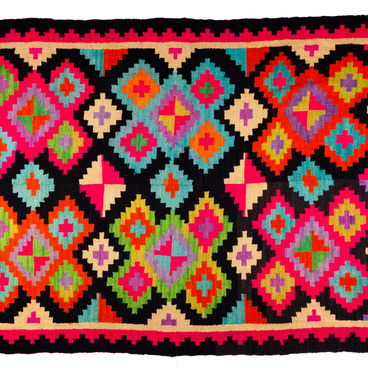A pouch — also called a kushel or kushil — is a rectangular travel shoulder bag with a flap. Usually, it was woven from bast or strips of birch bark using the technique of slanted weaving, and occasionally straight weaving. The museum showcases a pouch woven from bast in the XX century.
Along the perimeter, the pouch was sometimes decorated with a woven, embossed strip. The flap was usually held in place by ropes that were wrapped around special pieces of wood inserted along the open top part of the pouch. On its back wall, belts were frequently attached made of birch bark, leather, canvas, and hemp rope made in various ways. The pouch was used to carry food and other items to work, and it was taken on the road for the same purposes. It was indispensable during the hay harvest, in the fishing and hunting industries, or during long journeys.
Working with wood and wooden materials was a traditional occupation for Russian men. Using woodworking, all kinds of household utensils, dishes, and tools were produced. Bark, birch bark, and bast - the inner bark, or bast, of some deciduous trees — were used on a wide scale. The first mention of bast in Russian sources dates back to the XII-XIII centuries. In particular, in annals from 1205, bast is mentioned as one of the items given as tribute.
According to numerous historical records, bast has long been used as a durable and inexpensive material for weaving. It was used very frequently to weave bast sandals. This type of shoe was popular not only among farmers, but also among townspeople. Until the second half of the 19th century, bast sandals continued to be the main shoes worn in the villages and hamlets of the black earth farming provinces. In some rural regions, they were worn right up to the middle of the XX century.
Mats and ropes were also woven from bast. Bast ropes were widely used in fishing and hunting, as well as in agriculture. These ropes were fairly resistant to abrasion and water. Bast was also used to make toys for children. Dolls were knitted from it, and it could supplement with wooden toys — for example, to make manes and tails for horses, or braids for dolls. Some items made from bast are still popular now. For example, washcloths, bath slippers, simple head coverings, and some other accessories are still made from bast.
Along the perimeter, the pouch was sometimes decorated with a woven, embossed strip. The flap was usually held in place by ropes that were wrapped around special pieces of wood inserted along the open top part of the pouch. On its back wall, belts were frequently attached made of birch bark, leather, canvas, and hemp rope made in various ways. The pouch was used to carry food and other items to work, and it was taken on the road for the same purposes. It was indispensable during the hay harvest, in the fishing and hunting industries, or during long journeys.
Working with wood and wooden materials was a traditional occupation for Russian men. Using woodworking, all kinds of household utensils, dishes, and tools were produced. Bark, birch bark, and bast - the inner bark, or bast, of some deciduous trees — were used on a wide scale. The first mention of bast in Russian sources dates back to the XII-XIII centuries. In particular, in annals from 1205, bast is mentioned as one of the items given as tribute.
According to numerous historical records, bast has long been used as a durable and inexpensive material for weaving. It was used very frequently to weave bast sandals. This type of shoe was popular not only among farmers, but also among townspeople. Until the second half of the 19th century, bast sandals continued to be the main shoes worn in the villages and hamlets of the black earth farming provinces. In some rural regions, they were worn right up to the middle of the XX century.
Mats and ropes were also woven from bast. Bast ropes were widely used in fishing and hunting, as well as in agriculture. These ropes were fairly resistant to abrasion and water. Bast was also used to make toys for children. Dolls were knitted from it, and it could supplement with wooden toys — for example, to make manes and tails for horses, or braids for dolls. Some items made from bast are still popular now. For example, washcloths, bath slippers, simple head coverings, and some other accessories are still made from bast.



